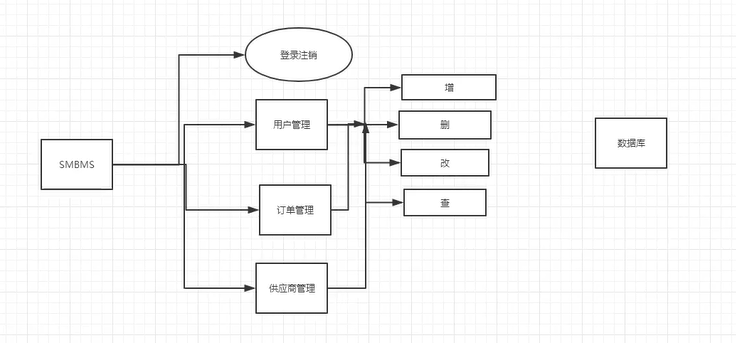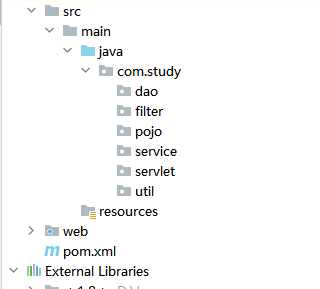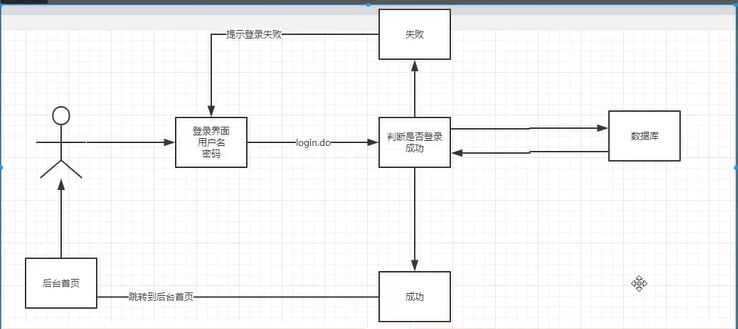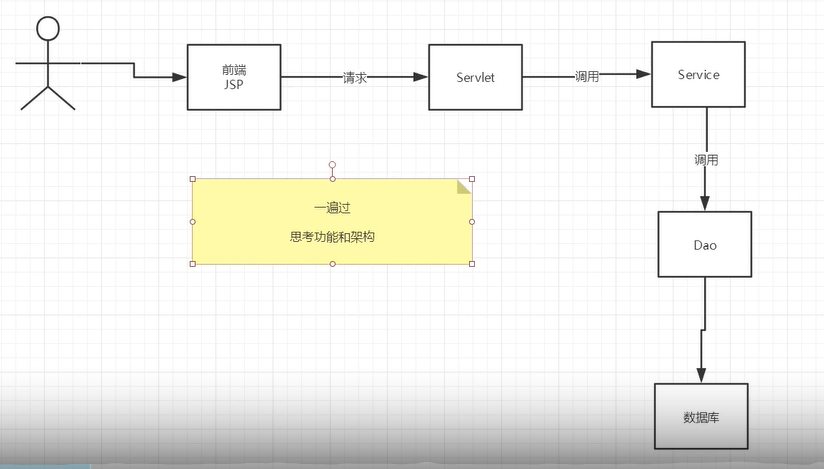超市管理统SMBMS笔记
原理图

数据库:

项目如何搭建?
考虑使用不使用Maven ? 依赖,Jar
项目搭建准备工作
-
搭建一个maven web项目
-
配置Tomcat
-
测试项目是否能够跑起来
-
导入项目中会遇到的jar包
sevlet-api,jsp-api,jstl,jstl-api,mysql-connector-java
-
构建项目框架

-
编写实体类
ORM:表-类映射
-
编写基础公共类
-
数据库配置文件
diver=com.mysql.jdbc.Driver url=jdbc:mysql://localhost:3306/smbms?useUnicode=true&characterEncoding=utf-8&serverTimezone=GMT%2B8 username=root password=123456
-
编写数据库的公共类
1 package com.study.dao; 2 3 import java.io.IOException; 4 import java.io.InputStream; 5 import java.sql.*; 6 import java.util.Properties; 7 //操作数据库的公共类 8 public class BaseDao { 9 private static String driver; 10 private static String url; 11 private static String username; 12 private static String password; 13 14 //静态代码块,类加载的时候就初始化了 15 static{ 16 Properties properties = new Properties(); 17 //通过类加载器获取对用的资源 18 InputStream is = BaseDao.class.getClassLoader().getResourceAsStream("db.properties"); 19 20 try { 21 properties.load(is); 22 } catch (IOException e) { 23 e.printStackTrace(); 24 } 25 26 driver = properties.getProperty("driver"); 27 url = properties.getProperty("url"); 28 username = properties.getProperty("username"); 29 password = properties.getProperty("password"); 30 } 31 //获取数据库的连接 32 public static Connection getConnection(){ 33 Connection connection = null; 34 try { 35 connection = DriverManager.getConnection(url, username, password); 36 } catch (SQLException e) { 37 e.printStackTrace(); 38 } 39 return connection; 40 } 41 //编写查询公共类 42 public static ResultSet excute(Connection connection, String sql, Object[] params, ResultSet resultSet, PreparedStatement preparedStatement) throws SQLException { 43 //预编译的sql,在后面直接执行就可以了 44 preparedStatement = connection.prepareStatement(sql); 45 46 for (int i = 0; i < params.length; i++) { 47 //setObject,占位符从1开始,但是我们的数组是从0开始! 48 preparedStatement.setObject(i+1,params[i]); 49 } 50 51 resultSet = preparedStatement.executeQuery(); 52 return resultSet; 53 } 54 55 //编写增删改公共类 56 public static int excute(Connection connection,String sql,Object[] params,PreparedStatement preparedStatement) throws SQLException { 57 preparedStatement = connection.prepareStatement(sql); 58 59 for (int i = 0; i < params.length; i++) { 60 //setObject,占位符从1开始,但是我们的数组是从0开始! 61 preparedStatement.setObject(i+1,params[i]); 62 } 63 64 int updateRows = preparedStatement.executeUpdate(); 65 return updateRows; 66 } 67 68 //释放资源 69 public static boolean closeResourse(Connection connection,PreparedStatement preparedStatement,ResultSet resultSet){ 70 boolean flag = true; 71 72 if (resultSet!=null){ 73 try { 74 resultSet.close(); 75 //GC回收 76 resultSet = null; 77 } catch (SQLException e) { 78 e.printStackTrace(); 79 flag = false; 80 } 81 } 82 83 if (preparedStatement!=null){ 84 try { 85 preparedStatement.close(); 86 //GC回收 87 preparedStatement = null; 88 } catch (SQLException e) { 89 e.printStackTrace(); 90 flag = false; 91 } 92 } 93 94 if (connection!=null){ 95 try { 96 connection.close(); 97 //GC回收 98 connection = null; 99 } catch (SQLException e) { 100 e.printStackTrace(); 101 flag = false; 102 } 103 } 104 return flag; 105 } 106 }
-
编写字符编码过滤器
-
-
导入静态资源
登录功能实现

-
设置首页
<!-- 设置欢迎页面 --> <welcome-file-list> <welcome-file>login.jsp</welcome-file> </welcome-file-list> -
编写dao层登录用户的接口
public interface UserDao { //得到要登录的用户 public User getLoginUser(Connection connection, String userCode) throws SQLException; }
-
编写dao层接口的实现类
1 package com.study.dao.user; 2 3 import com.study.dao.BaseDao; 4 import com.study.pojo.User; 5 6 import java.sql.Connection; 7 import java.sql.PreparedStatement; 8 import java.sql.ResultSet; 9 import java.sql.SQLException; 10 11 public class UserDaoImpl implements UserDao{ 12 //得到要登录的用户 13 public User getLoginUser(Connection connection, String userCode) throws SQLException { 14 PreparedStatement pstm = null; 15 ResultSet rs = null; 16 User user = null; 17 18 if (connection!=null){ 19 String sql = "select * from smbms_user where userCode = ?"; 20 Object[] params = {userCode}; 21 22 rs = BaseDao.excute(connection, pstm, rs, sql, params); 23 24 if(rs.next()){ 25 user = new User(); 26 user.setId(rs.getInt("id")); 27 user.setUserCode(rs.getString("userCode")); 28 user.setUserName(rs.getString("userName")); 29 user.setUserPassword(rs.getString("userPassword")); 30 user.setGender(rs.getInt("gender")); 31 user.setBirthday(rs.getDate("birthday")); 32 user.setPhone(rs.getString("phone")); 33 user.setAddress(rs.getString("address")); 34 user.setUserRole(rs.getInt("userRole")); 35 user.setCreateBy(rs.getInt("createdBy")); 36 user.setCreationDate(rs.getTimestamp("creationDate")); 37 user.setModifyBy(rs.getInt("modifyBy")); 38 user.setModifyDate(rs.getTimestamp("modifyDate")); 39 } 40 BaseDao.closeResourse(null,pstm,rs);//connection不关,业务层可能要用 41 } 42 return user; 43 } 44 }
-
业务层接口
public interface UserService { //用户登录 public User login(String userCode, String password); }
-
业务层实现类
1 package com.study.service.user; 2 3 import com.study.dao.BaseDao; 4 import com.study.dao.user.UserDao; 5 import com.study.dao.user.UserDaoImpl; 6 import com.study.pojo.User; 7 import org.junit.Test; 8 9 import java.sql.Connection; 10 import java.sql.SQLException; 11 12 public class UserServiceImpl implements UserService{ 13 14 //业务层都会调用dao层,所以我们要引入Dao层 15 private UserDao userDao; 16 public UserServiceImpl(){ 17 userDao = new UserDaoImpl(); 18 } 19 public User login(String userCode, String password) { 20 Connection connection = null; 21 User user = null; 22 try { 23 connection = BaseDao.getConnection(); 24 //业务层调用对应的具体数据库操作 25 user = userDao.getLoginUser(connection, userCode); 26 } catch (SQLException e) { 27 e.printStackTrace(); 28 }finally { 29 BaseDao.closeResourse(connection,null,null); 30 } 31 return user; 32 } 33 34 @Test 35 public void test(){ 36 UserServiceImpl userService = new UserServiceImpl(); 37 User admin = userService.login("admin", "dhewfghewe"); 38 System.out.println(admin.getUserPassword()); 39 } 40 }
-
编写Servlet
1 package com.study.servlet.user; 2 3 import com.study.dao.user.UserDaoImpl; 4 import com.study.pojo.User; 5 import com.study.service.user.UserService; 6 import com.study.service.user.UserServiceImpl; 7 import com.study.util.Constants; 8 import jakarta.servlet.ServletException; 9 import jakarta.servlet.http.HttpServlet; 10 import jakarta.servlet.http.HttpServletRequest; 11 import jakarta.servlet.http.HttpServletResponse; 12 13 import java.io.IOException; 14 15 public class LoginServlet extends HttpServlet { 16 17 //Servlet:控制层,调用业务层代码 18 @Override 19 protected void doGet(HttpServletRequest req, HttpServletResponse resp) throws ServletException, IOException { 20 21 System.out.println("LoginServlet--start...."); 22 23 //获取用户名和密码 24 String userCode = req.getParameter("userCode"); 25 String userPassword = req.getParameter("userPassword"); 26 27 //和数据库中的密码进行对比,调用业务层; 28 UserService userService = new UserServiceImpl(); 29 User user = userService.login(userCode, userPassword); 30 31 if (user!=null){//查有此人,可以登录 32 //将用户的信息放到Session中; 33 req.getSession().setAttribute(Constants.USER_SESSION,user); 34 //跳转到主页 35 resp.sendRedirect("jsp/frame.jsp"); 36 }else{//查无此人,无法登录 37 //转发会登录界面,顺带提示它,用户名或者密码错误; 38 req.setAttribute("error","用户名或者密码不正确"); 39 req.getRequestDispatcher("login.jsp").forward(req,resp); 40 41 } 42 43 } 44 45 @Override 46 protected void doPost(HttpServletRequest req, HttpServletResponse resp) throws ServletException, IOException { 47 doGet(req, resp); 48 } 49 }
-
注册Servlet
<servlet> <servlet-name>LoginServlet</servlet-name> <servlet-class>com.study.servlet.user.LoginServlet</servlet-class> </servlet> <servlet-mapping> <servlet-name>LoginServlet</servlet-name> <url-pattern>/login.do</url-pattern> </servlet-mapping>
-
测试访问,确保以上能成功
登录功能优化
注销功能:
思路:移除Session,返回登录界面
1 package com.study.servlet.user; 2 3 import com.study.util.Constants; 4 import jakarta.servlet.ServletException; 5 import jakarta.servlet.http.HttpServlet; 6 import jakarta.servlet.http.HttpServletRequest; 7 import jakarta.servlet.http.HttpServletResponse; 8 9 import java.io.IOException; 10 11 public class LogoutServlet extends HttpServlet { 12 @Override 13 protected void doGet(HttpServletRequest req, HttpServletResponse resp) throws ServletException, IOException { 14 //移除用户的Constants.USER_SESSION 15 req.getSession().removeAttribute(Constants.USER_SESSION); 16 resp.sendRedirect(req.getContextPath()+"/login.jsp");//返回登录界面 17 } 18 19 @Override 20 protected void doPost(HttpServletRequest req, HttpServletResponse resp) throws ServletException, IOException { 21 doGet(req, resp); 22 } 23 }
注册
<servlet> <servlet-name>LogoutServlet</servlet-name> <servlet-class>com.study.servlet.user.LogoutServlet</servlet-class> </servlet> <servlet-mapping> <servlet-name>LogoutServlet</servlet-name> <url-pattern>/jsp/logout.do</url-pattern> </servlet-mapping>
登录拦击优化
编写一个过滤器,并注册
package com.study.filter; import com.study.pojo.User; import com.study.util.Constants; import jakarta.servlet.*; import jakarta.servlet.http.HttpServlet; import jakarta.servlet.http.HttpServletRequest; import jakarta.servlet.http.HttpServletResponse; import java.io.IOException; public class SysFilter implements Filter { public void init(FilterConfig filterConfig) throws ServletException { } public void doFilter(ServletRequest req, ServletResponse resp, FilterChain chain) throws IOException, ServletException { HttpServletRequest request = (HttpServletRequest) req; HttpServletResponse response = (HttpServletResponse) resp; //过滤器,从Session中获取用户 User user = (User)request.getSession().getAttribute(Constants.USER_SESSION); if(user==null){//已经被一处或者注销了,或者未登录 response.sendRedirect("/error.jsp"); }else{ chain.doFilter(req,resp); } } public void destroy() { } }
<!-- 用户过滤器 --> <filter> <filter-name>SysFilter</filter-name> <filter-class>com.study.filter.SysFilter</filter-class> </filter> <filter-mapping> <filter-name>SysFilter</filter-name> <url-pattern>/jsp/*</url-pattern> </filter-mapping>
测试,登录,注销,权限,都要保证OK!
-
导入前端素材
<li><a href="${pageContext.request.contextPath }/jsp/pwdmodify.jsp">密码修改</a></li> <li><a href="${pageContext.request.contextPath }/jsp/logout.do">退出系统</a></li>
-
写项目,建议从底层往上写

-
UserDao接口
//修改当前用户密码 public int updatePwd(Connection connection,int id,int password) throws SQLException;
-
UserDao实现类
public int updatePwd(Connection connection, int id, int password) throws SQLException { PreparedStatement pstm = null; int excute = 0; if (connection!=null){ String sql = "update smbms_user set userPassword = ? where id = ?"; Object[] params = {password,id}; excute = BaseDao.excute(connection, pstm, sql, params); BaseDao.closeResourse(null,pstm,null); } return excute; }
-
UserService层
//根据用户ID修改密码 public boolean updatePwd(int id, int pwd);
-
UserService实现类
1 public boolean updatePwd(int id, int pwd) { 2 Connection connection = null; 3 boolean flag = false; 4 5 //修改密码 6 try { 7 connection = BaseDao.getConnection(); 8 if (userDao.updatePwd(connection, id, pwd) > 0){ 9 flag = true; 10 } 11 } catch (SQLException e) { 12 e.printStackTrace(); 13 }finally { 14 BaseDao.closeResourse(connection,null,null); 15 } 16 return flag; 17 } 18 19 //记得注册
-
记得实现复用,需要提出方法!
@Override protected void doGet(HttpServletRequest req, HttpServletResponse resp) throws ServletException, IOException { String method = req.getParameter("method"); if (method.equals("savepwd")&&method!=null){ this.updatePwd(req,resp); } }
-
测试
优化密码修改使用Ajax
-
阿里巴巴的fastjson
<dependency> <groupId>com.alibaba</groupId> <artifactId>fastjson</artifactId> <version>1.2.80</version> </dependency>
-
后台代码修改
1 //修改密码 2 public void updatePwd(HttpServletRequest req, HttpServletResponse resp){ 3 //从Session里面拿ID; 4 Object o = req.getSession().getAttribute(Constants.USER_SESSION); 5 String newpassword = req.getParameter("newpassword"); 6 boolean flag = false; 7 8 if(o!=null && !StringUtils.isNullOrEmpty(newpassword)){ 9 UserService userService = new UserServiceImpl(); 10 flag = userService.updatePwd(((User)o).getId(), newpassword); 11 if (flag){ 12 req.setAttribute("message","修改密码成功,请推出,使用新密码登录"); 13 //密码修改成功,移除当前Session 14 req.getSession().removeAttribute(Constants.USER_SESSION); 15 }else{ 16 req.setAttribute("message","修改密码失败"); 17 } 18 }else { 19 req.setAttribute("message","新密码有问题"); 20 } 21 22 try { 23 resp.sendRedirect("pwdmodify.jsp"); 24 } catch (IOException e) { 25 e.printStackTrace(); 26 } 27 } 28 29 //验证旧密码,session中有用户的密码 30 public void pwdModify(HttpServletRequest req, HttpServletResponse resp){ 31 //从Session里面拿ID; 32 Object o = req.getSession().getAttribute(Constants.USER_SESSION); 33 String oldpassword = req.getParameter("oldpassword"); 34 35 //万能的Map : 结果集 36 Map<String, String> resultMap = new HashMap<String, String>(); 37 38 if(o==null){//session失效了,session过期了 39 resultMap.put("result","sessionerror"); 40 }else if(StringUtils.isNullOrEmpty(oldpassword)){//输入的密码为空 41 resultMap.put("result","error"); 42 }else{ 43 String userPassword = ((User) o).getUserPassword();//Session中用户的密码 44 if (oldpassword.equals(userPassword)){ 45 resultMap.put("result","true"); 46 }else{ 47 resultMap.put("result","false"); 48 } 49 } 50 51 try { 52 resp.setContentType("application/json"); 53 PrintWriter writer = null; 54 writer = resp.getWriter(); 55 //JSONArray 阿里巴巴的JSON工具类,转换格式 56 /* 57 * resultMap = ["result","sessionerror","result","error"] 58 * JSON格式 = {key:value} 59 * */ 60 writer.write(JSONArray.toJSONString(resultMap)); 61 writer.flush(); 62 writer.close(); 63 } catch (IOException e) { 64 e.printStackTrace(); 65 } 66 }
-
测试
用户管理实现
思路:

-
要导入分页的工具类
-
用户列表页面导入
userlist.jsp
rollpage.jsp
获取用户数量
UserDao
//根据用户名或者角色查询用户数量 public int getUserCount(Connection connection,String username,int userRole)throws SQLException;
UserDaoImpl
1 //根据用户名或者角色查询用户数量 2 public int getUserCount(Connection connection, String username, int userRole) throws SQLException { 3 PreparedStatement pstm = null; 4 ResultSet rs = null; 5 int count = 0; 6 7 if (connection!=null){ 8 StringBuffer sql = new StringBuffer(); 9 sql.append("select count(1) as count from smbms_user u,smbms_role r where u.userRole = r.id"); 10 ArrayList<Object> list = new ArrayList<Object>();//存放我们的参数 11 12 if (!StringUtils.isNullOrEmpty(username)){ 13 sql.append(" and u.userName like ?"); //and前需要一个空格,否则sql拼接的时候有问题 14 list.add("%"+username+"%");//index:0 15 } 16 17 if(userRole>0){ 18 sql.append(" and u.userRole = ?"); 19 list.add(userRole);//index:1 20 } 21 22 //怎么把list转成数组 23 Object[] params = list.toArray(); 24 25 System.out.println("UserDaoIml-->getUserCount:"+sql.toString());//输出最后完整的代码 26 27 rs = BaseDao.excute(connection, pstm, rs, sql.toString(), params); 28 29 if (rs.next()){ 30 count = rs.getInt("count");//从结果集中获得最终的数量 31 } 32 BaseDao.closeResourse(null,pstm,rs); 33 } 34 return count; 35 }
UserService
//查询记录数 public int getUserCount(String username,int userRole);
UserServiceImpl
//查询记录数 public int getUserCount(String username, int userRole) { Connection connection = null; int count = 0; try { connection = BaseDao.getConnection(); count = userDao.getUserCount(connection, username, userRole); } catch (SQLException e) { e.printStackTrace(); }finally { BaseDao.closeResourse(connection,null,null); } return count; }
获取用户列表
UserDao
//根据用户条件获取用户列表 public List<User> getUserList(Connection connection,String userName,int userRole,int currentPageNo,int pageSize)throws Exception;
UserDaoImpl
1 //根据用户条件获取用户列表 2 public List<User> getUserList(Connection connection, String userName, int userRole, int currentPageNo, int pageSize) throws Exception { 3 PreparedStatement pstm = null; 4 ResultSet rs = null; 5 List<User> userList = new ArrayList<User>(); 6 if (connection!=null){ 7 StringBuffer sql = new StringBuffer(); 8 sql.append("select u.*,r.roleName as userRoleName from smbms_user u,smbms_role r where u.userRole = r.id"); 9 List<Object> list = new ArrayList<Object>();//存放我们的参数 10 11 if (!StringUtils.isNullOrEmpty(userName)){ 12 sql.append(" and u.userName like ?"); //and前需要一个空格,否则sql拼接的时候有问题 13 list.add("%"+userName+"%");//index:0 14 } 15 16 if(userRole>0){ 17 sql.append(" and u.userRole = ?"); 18 list.add(userRole);//index:1 19 } 20 sql.append(" order by creationDate DESC limit ?,?"); 21 currentPageNo = (currentPageNo-1)*pageSize; 22 list.add(currentPageNo); 23 list.add(pageSize); 24 25 Object[] params = list.toArray(); 26 System.out.println("sql-->"+sql.toString()); 27 rs = BaseDao.excute(connection, pstm, rs, sql.toString(), params); 28 while (rs.next()){ 29 User _user = new User(); 30 _user.setId(rs.getInt("id")); 31 _user.setUserCode(rs.getString("userCode")); 32 _user.setUserName(rs.getString("userName")); 33 _user.setGender(rs.getInt("gender")); 34 _user.setBirthday(rs.getDate("birthday")); 35 _user.setPhone(rs.getString("phone")); 36 _user.setAddress(rs.getString("address")); 37 _user.setUserRole(rs.getInt("userRole")); 38 _user.setCreateBy(rs.getInt("createdBy")); 39 userList.add(_user); 40 } 41 BaseDao.closeResourse(null,pstm,rs); 42 } 43 return userList; 44 }
UserService
//根据条件查询用户列表 public List<User> getUserList(String queryUserName,int queryUserRole,int currentPageNo,int pageSize);
UserServiceImpl
1 //根据条件查询用户列表 2 public List<User> getUserList(String queryUserName, int queryUserRole, int currentPageNo, int pageSize) { 3 Connection connection = null; 4 List<User> userList = null; 5 System.out.println("queryUserName--->"+queryUserName); 6 System.out.println("queryUserRole--->"+queryUserRole); 7 System.out.println("currentPageNo--->"+currentPageNo); 8 System.out.println("pageSize--->"+pageSize); 9 10 try { 11 connection = BaseDao.getConnection(); 12 userList = userDao.getUserList(connection,queryUserName,queryUserRole,currentPageNo,pageSize); 13 } catch (Exception e) { 14 e.printStackTrace(); 15 }finally { 16 BaseDao.closeResourse(connection,null,null); 17 } 18 return userList; 19 }
获取角色列表
为了我们职责统一,可以把角色的操作单独放在一个包中,和POJO类对应
RoleDao
//获取角色列表 public List<Role> getRoleList(Connection connection)throws SQLException;
RoleDaoImpl
//获取角色列表 public List<Role> getRoleList(Connection connection) throws SQLException { PreparedStatement pstm = null; ResultSet rs = null; ArrayList<Role> roleList = new ArrayList<Role>(); if(connection!=null){ String sql = "select * from smbms_role"; Object[] parame = {}; rs = BaseDao.excute(connection,pstm,rs,sql,parame); while(rs.next()){ Role _role = new Role(); _role.setId(rs.getInt("id")); _role.setRoleCode(rs.getString("roleCode")); _role.setRoleName(rs.getString("roleName")); roleList.add(_role); } BaseDao.closeResourse(null,pstm,rs); } return roleList; }
RoleService
//获取角色列表 public List<Role> getRoleList();
RoleServiceImpl
package com.study.service.role; import com.study.dao.BaseDao; import com.study.dao.role.RoleDao; import com.study.dao.role.RoleDaoImpl; import com.study.pojo.Role; import javax.sql.RowSetInternal; import java.sql.Connection; import java.sql.SQLException; import java.util.List; public class RoleServiceImpl implements RoleService { //引入Dao private RoleDao roleDao; public RoleServiceImpl(){ roleDao = new RoleDaoImpl(); } //获取角色列表 public List<Role> getRoleList() { Connection connection = null; List<Role> roleList = null; try { connection = BaseDao.getConnection(); roleList = roleDao.getRoleList(connection); } catch (SQLException e) { e.printStackTrace(); }finally { BaseDao.closeResourse(connection,null,null); } return roleList; } }
用户用于显示的Servlet
-
获取用户前端的数据(查询)1. 获取用户前端的数据(查询)
-
判断请求是否需要执行,看参数的值判断
-
为了实现分页,需要极端当前页面合总页数,页面大小……
-
用户列表展示
-
返回前端
1 //重点、难点 2 public void query(HttpServletRequest req, HttpServletResponse resp){ 3 4 //查询用户列表 5 6 //从前端端获取数据: 7 String queryUserName = req.getParameter("queryname"); 8 String temp = req.getParameter("queryUserRole"); 9 String pageIndex = req.getParameter("pageIndex"); 10 int queryUserRole = 0; 11 12 //获取用户列表 13 UserServiceImpl userService = new UserServiceImpl(); 14 List<User> userList = null; 15 16 //第一次走这个请求,一定是第一页,页面大小是固定的: 17 int pageSize = 5;//可以把这个写到配置中,方便否其修改; 18 int currentPageNo = 1; 19 20 if(queryUserName == null){ 21 queryUserName = ""; 22 } 23 if (temp!=null&&!temp.equals("")){ 24 queryUserRole = Integer.parseInt(temp);//给查询赋值!0,1,2,3 25 } 26 if (pageIndex!=null){ 27 currentPageNo = Integer.parseInt(pageIndex); 28 } 29 30 //获取用户的总数(分页:上一页,下一页的情况) 31 int totalCount = userService.getUserCount(queryUserName, queryUserRole); 32 //总页数支持 33 PageSupport pageSupport = new PageSupport(); 34 pageSupport.setCurrentPageNo(currentPageNo); 35 pageSupport.setPageSize(pageSize); 36 pageSupport.setTotalCount(totalCount); 37 38 int totalPageCount = ((int)(totalCount/pageSize))+1;//总的页数 39 40 //控制首页和页面 41 //如果页面要小于1,就显示第一页的东西 42 if(currentPageNo<1){ 43 currentPageNo = 1; 44 }else if(currentPageNo>totalPageCount){//当前页面大于最后一页 45 currentPageNo = totalPageCount; 46 } 47 48 //获取用户列表展示 49 userList = userService.getUserList(queryUserName,queryUserRole,currentPageNo,pageSize); 50 req.setAttribute("userList",userList); 51 52 RoleServiceImpl roleService = new RoleServiceImpl(); 53 List<Role> roleList = roleService.getRoleList(); 54 req.setAttribute("roleList",roleList); 55 req.setAttribute("totalCount",totalCount); 56 req.setAttribute("currentPageNo",currentPageNo); 57 req.setAttribute("totalPageCount",totalPageCount); 58 req.setAttribute("queryUserName",queryUserName); 59 req.setAttribute("queryUserRole",queryUserRole); 60 61 //返回前端 62 try { 63 req.getRequestDispatcher("userlist.jsp").forward(req,resp); 64 } catch (ServletException e) { 65 e.printStackTrace(); 66 } catch (IOException e) { 67 e.printStackTrace(); 68 } 69 }



 浙公网安备 33010602011771号
浙公网安备 33010602011771号